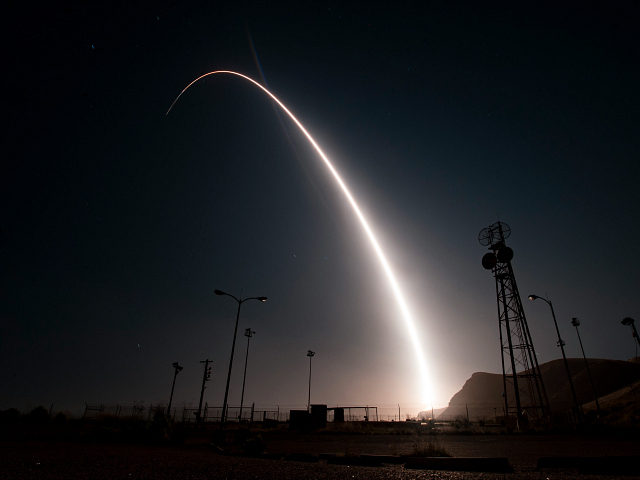The Pentagon announced Tuesday that it successfully intercepted an intercontinental ballistic missile target for the first time, in a test aimed at neutralizing the threat from North Korea and Iran’s growing missile capabilities.
The test was the first live-fire test against an ICBM-class target by the combination of the Ground-based Midcourse Defense (GMD) interceptor and the U.S. ballistic missile defense system, according to the U.S. Missile Defense Agency.
An ICBM-class target was launched from the Reagan Test Site on Kwajalein Atoll in the Republic of the Marshall Islands. Sea and space-based radars sent tracking and targeting data to the GMD. A ground-based interceptor was launched from Vandenberg Air Force Base in California, and its “exo-atmospheric kill vehicle intercepted and destroyed the target in a direct collision,” the statement said.
The intercept is “an incredible accomplishment for the GMD system and a critical milestone for this program,” said MDA Director Navy Vice Adm. Jim Syring, adding:
This system is vitally important to the defense of our homeland, and this test demonstrates that we have a capable, credible deterrent against a very real threat. I am incredibly proud of the warfighters who executed this test and who operate this system every day.
The test was conducted by the MDA, the U.S. Air Force 30th Space Wing, the Joint Functional Component Command for Integrated Missile Defense and U.S. Northern Command.
Defense contractor Raytheon, who produced the exo-atmospheric kill vehicle (EKV) that slammed into the target, also cheered the test, which was the tenth time the GMD system had intercepted its target outside of the Earth’s atmosphere, in space. “This test keeps the United States on track to increase its ground-based interceptor inventory to 44 in 2017,” said Raytheon Missile Systems’ president Dr. Taylor W. Lawrence. “This system is among our industry’s most complex, and its advancement ensures the protection of the U.S. and its allies.”
Earlier in the day, the Pentagon had portrayed the test as a response to a threat from North Korea, which has sped up development of missiles that could someday carry a nuclear weapon to the U.S. homeland. “While this is not a test that’s timed specifically to the current tensions in North Korea, in a more broad sense, obviously North Korea is one of the reasons why we have this capability,” Pentagon spokesman Navy Capt. Jeff Davis told reporters that day.
Davis said Iran’s missile program is another reason the U.S. is developing its missile defense capabilities. “Iran also continues to develop more sophisticated missiles and approve the range and accuracy of current missile systems. Their ballistic missile capability will continue to threaten U.S. strategic interests in the Middle East,” he said.
Tuesday’s test would bring the GMD’s success rate to 10 out of 18 tests, or 55 percent.
Not all were pleased by the test, however.
The Center for Arms Control and Non-Proliferation, a national non-partisan, non-profit organization, said the $40 billion GMD system has had only a 40 percent success rate in its last five tests since 2004, and that the tests have all been “highly scripted for success” and do not represent realistic war conditions. “In school, 40 percent isn’t a passing grade. The GMD program has a long way to go,” said Philip E. Coyle, a senior science fellow at the Center who formerly headed the Pentagon’s office of operational test and evaluation.

COMMENTS
Please let us know if you're having issues with commenting.